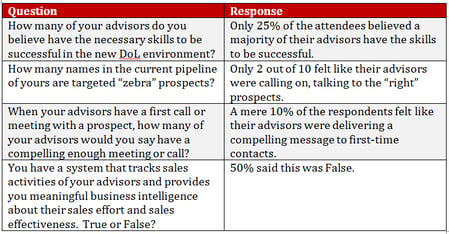We recently delivered a webinar specifically for one of our clients – BISA (Bank Insurance and Securities Association). The topic was The Customer-First Advisor: How to Help Your Salespeople Survive and Sell in the Coming DOL Environment – regarding the recent Department of Labor ruling outlining the fiduciary responsibilities of financial advisors giving advice to prospects or clients. (Click here to listen to recording.)
NOTE: This post doesn't just apply to investment advisor salespeople. Salespeople in all industries continue to face changes in economic, competitive and company climates. As a sales leader, it is important to recognize that those salespeople that got you where you are today probably won’t be the same ones that will get you through the other side of change unless you get them ready.
Up until this year, advisors had to satisfy a “suitability” standard when providing advice. The problem is that sometimes “suitability” also was conflicted advice. It was “conflicted” apparently because some of the products that were “suitable” were also the ones that paid the advisors the most commission. I have strong feelings about this and why the DoL would stick its nose in this… but that discussion is for another day and time!
As a result, one of the issues at hand is how advisors actually conduct themselves now that there are new regs in place. During our webinar (click here to listen to recording),we asked a couple of poll questions. Here are those questions and responses:

What does this tell us – you?
- Skills to be successful – If you look at your sales results in a 80/20 power curve, you always see that about 36% of your team represents close to 90% of the sales results. What does that tell you about the rest of the team? Answer: They either fail in effort or execution of the process, or they lack skills. Question: Did you hire them that way or make them that way?
- Pipeline – The question applies to anyone selling anything but ESPECIALLY if you are selling products and services of higher dollar amounts and selling B2B. Not everyone that fogs a mirror is a prospect. Yes, people may call you out of the blue, walk into your office and ask to buy. Sell them! But, day in and day out, your salespeople need to be looking for and talking to Zebras. (click here for book)
- Depending on how your salespeople go to the market, the first contact has to be compelling. One of our rules is this: “Don’t look, act or sound like a salesperson.” If your people open up with how good the company is, great pricing and unbelievable service, then they are bringing nothing to the conversation that is compelling. REMEMBER THIS from Verne Harnish in Scaling UP – People are distracted. Prospects have lots of other people looking to take their time. You must have a compelling message in order to get people to keep listening.
- Tracking is the name of the game when it comes to performance management. Lots of companies talk about performance management, but normally all that means is that there is an arbitrary line that someone has to cross before they go on a PIP – Performance Improvement Program. By then, it’s normally too late. The key to performance management is to have systems and processes in place so that you can “catch them early”.
What does this mean? It means the following:
- Regardless of the levels of success in your organization, you should constantly invest in your people so that they continue to improve important skills and learn new ones.
- Make sure that your salespeople clearly understand the ideal client in your organization and make sure that you have a process to “inspect what you expect” in terms of what segment of the market you are capturing.
- Review your go-to-market messaging and ask yourself – “Does this really differentiate us from the market or are we trying to sell the same message everyone else is?”
- Identify your sales steps. Have a process in place to calculate exactly how many of each step each salesperson has to execute in order to succeed. Make sure that you have assumptions about the conversion ratios from one step to the next step. These ratios will vary from person to person. Collect actual performance results. Compare actual activity and effectiveness to target activity and effectiveness.
Additional Resources:
Building a Sales Formula for Success – Link to success formula
Tracking – Sample output of data collected



